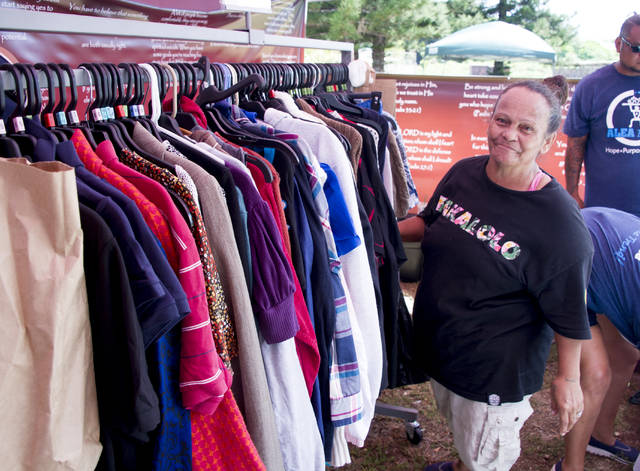18 agencies offer services to homeless in Waipahu

CRAIG T. KOJIMA / CKOJIMA@STARADVERTISER.COM
Kori Takemoto helped relative Sai Late with a new shirt he got from a homeless outreach fair Thursday at the Plantation Village in Waipahu.

CRAIG T. KOJIMA / CKOJIMA@STARADVERTISER.COM
Vanessa Williams looked through donated clothing at an outreach fair for the homeless in Waipahu.


Following a sweep of homeless encampments in Waipahu in May that saw the typical return of tents and tarps, 18 agencies last week offered services at Hawaii’s Plantation Village in an effort to get nearby homeless people one step closer to seeking help.
“Realistically, we’re not going to house anybody today,” said Phil Acosta, executive director of the non-profit ALEA Bridge organization that’s working to reduce homelessness. “Just making an initial contact — that would be a win for us.”
The modest goal of Thursday’s effort underscored the ongoing challenge that social service outreach workers, government agencies and non-profit groups face while trying to help Hawaii’s chronically homeless who help drive the largest per capita homeless population in America.
In a January head count of the island’s homeless, the Ewa area that includes Waipahu saw a 14.4 percent increase in its homeless population — to 193 people from 170 people in 2016.
About 40 or so homeless people are believed to live directly around Hawaii’s Plantation Village. Last week’s efforts by outreach workers attracted 45 people. The homeless were assisted by various groups and organizations, which included the Department of Education, state public health nurses, Legal Aid Society of Hawaii and state and city employment programs.
All of the homeless people there who spoke to the Honolulu Star-Advertiser said they’ve been living off the grid for years, sometimes decades.
Don't miss out on what's happening!
Stay in touch with breaking news, as it happens, conveniently in your email inbox. It's FREE!
“Pretty much, they’re all locals,” said Acosta’s brother, Joe Acosta, director of operations for ALEA Bridge.
There are many others who did not show up and have no intention of seeking help, Phil Acosta said.
“Several are resistant to coming in and engaging us,” he said.
Those who did attend were offered a range of services including free food, clothes, health care, reading glasses, access to government benefits and help acquiring government identification, which is necessary to get a job or housing.
Sai Late, 62, gladly accepted a pair of reading glasses from Project Vision Hawaii workers but said he has no intention of leaving his roving encampment around the re-creation of Hawaii’s plantation era.
Asked where he sleeps, Late pointed to various spots on the outskirts of Hawaii’s Plantation Village and said, “I love this place. I don’t need housing, thank you very much.”
Larry Toro, who’s in charge of ground maintenance for the village, every morning scours the area around the administration building looking for human feces, urine and signs of vandalism.
He alleged that homeless people who live around the 20 replicas of plantation-era buildings regularly steal taro and bananas.
Toro said the weekend before he broke up a fight in front of the administration building that involved an umbrella and a replica pistol that one homeless person threw at another.
“It would be nice if they can get some of these people out of here,” Toro said.
Homeless people regularly use the village’s outdoor water spigots and electrical outlets and sometimes leave them vandalized, said Deanna Espinas, the village’s acting executive director.
After the city swept various encampments around the village in May, Espinas said the homeless occupants came right back and problems have persisted.
Asked how often workers find evidence that homeless people have been on the property, Espinas said, “Every day when we open up.”
Kori Takemoto, 36, has been homeless for eight years and lives in an encampment with her friends at nearby Hans L’Orange Park.
Takemoto arrived at the village on Thursday and saw services she could use: “ID and glasses and we need jobs,” she said.
Eventually, through repeated contacts by social service outreach workers, some of the homeless people who showed up Thursday may one day agree to abandon their encampments and move into housing, said Scott Morishige, the state’s homeless coordinator.
“We’re trying to connect people to services to start the process” of eventually getting into housing, Morishige said. “The main thing is making that initial connection. That’s the first step.”




